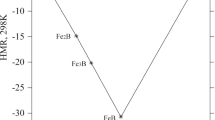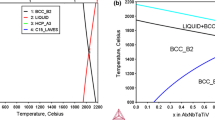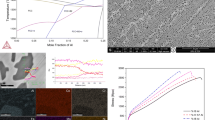Abstract
Based on the representative Co–Cr–Fe–Mn–Ni HEAs, many studies have been conducted to develop new HEAs with improved strength. The new HEA design can be efficient when utilizing computational thermodynamic prediction of phase equilibria because the phase distribution of alloys directly affects mechanical properties. Phase equilibria in HEAs can be effectively predicted by the CALPHAD (CALculation of PHAse Diagram) type thermodynamic calculation techniques, but the prediction of phase equilibria even for the well-known Co–Cr–Fe–Mn–Ni HEA system is still challenging due to the incompleteness of the thermodynamic descriptions for the constituent ternary systems. The purpose of the present work was to develop a self-consistent thermodynamic description for the quinary system by completing thermodynamic descriptions for all the constituent ternary sub-systems, newly carrying out thermodynamic assessments for the Co–Cr–Mn and Cr–Mn–Ni ternary systems. The reliability of the developed Co–Cr–Fe–Mn–Ni quinary thermodynamic description was confirmed by comparing calculated vertical sections of the quinary phase diagram with available experimental information.
Graphical abstract





Similar content being viewed by others
References
Tsai M-H, Yeh J-W (2014) High-entropy alloys: a critical review. Mater Res Lett 2:107–123. https://doi.org/10.1080/21663831.2014.912690
Yeh J-W, Chen SK, Lin SJ, Gan JY, Chin TS, Shun TT, Tsau CH, Chang SY (2004) Nanostructured high-entropy alloys with multiple principal elements: novel alloy design concepts and outcomes. Adv Eng Mater 6:299–303. https://doi.org/10.1002/adem.200300567
Gludovatz B, Hohenwarter A, Catoor D, Chang EH, George EP, Ritchie RO (2014) A fracture-resistant high-entropy alloy for cryogenic applications. Science 345:1153–1158. https://doi.org/10.1126/science.1254581
Jo YH, Jung S, Choi W-M, Sohn SS, Kim HS, Lee B-J, Kim NJ, Lee S (2017) Cryogenic strength improvement by utilizing room-temperature deformation twinning in a partially recrystallized VCrMnFeCoNi high-entropy alloy. Nat Commun 8:1–8. https://doi.org/10.1038/ncomms15719
Senkov ON, Wilks GB, Scott JM, Miracle DB (2011) Mechanical properties of Nb25Mo25Ta25W25 and V20Nb20Mo20Ta20W20 refractory high entropy alloys. Intermetallics 19:698–706. https://doi.org/10.1016/j.intermet.2011.01.004
Kumar NAPK, Li C, Leonard KJ, Bei H, Zinkle SJ (2016) Microstructural stability and mechanical behavior of FeNiMnCr high entropy alloy under ion irradiation. Acta Mater 113:230–244. https://doi.org/10.1016/j.actamat.2016.05.007
He MR, Wang S, Shi S, Jin K, Bei H, Yasuda K, Matsumura S, Higashida K, Robertson IM (2017) Mechanisms of radiation-induced segregation in CrFeCoNi-based single-phase concentrated solid solution alloys. Acta Mater 126:182–193. https://doi.org/10.1016/j.actamat.2016.12.046
Cantor B, Chang ITH, Knight P, Vincent AJB (2004) Microstructural development in equiatomic multicomponent alloys. Mater Sci Eng A 375–377:213–218. https://doi.org/10.1016/j.msea.2003.10.257
Ming K, Bi X, Wang J (2017) Microstructures and deformation mechanisms of Cr26Mn20Fe20Co20Ni14 alloys. Mater Charact 134:194–201. https://doi.org/10.1016/j.matchar.2017.10.022
Li Z, Pradeep KG, Deng Y, Raabe D, Tasan CC (2016) Metastable high-entropy dual-phase alloys overcome the strength-ductility trade-off. Nature 534:227–230. https://doi.org/10.1038/nature17981
Gao N, Lu DH, Zhao YY, Liu XW, Liu GH, Wu Y, Liu G, Fan ZT, Lu ZP, George EP (2019) Strengthening of a CrMnFeCoNi high-entropy alloy by carbide precipitation. J Alloy Compd 792:1028–1035. https://doi.org/10.1016/j.jallcom.2019.04.121
Wang Z, Baker I, Guo W, Poplawsky JD (2017) The effect of carbon on the microstructures, mechanical properties, and deformation mechanisms of thermo-mechanically treated Fe40.4Ni11.3Mn34.8Al7.5Cr6 high entropy alloys. Acta Mater. 126:346–360. https://doi.org/10.1016/j.actamat.2016.12.074
Peng H, Hu L, Li L, Gao J, Zhang Q (2020) On the correlation between L12 nanoparticles and mechanical properties of (NiCo)52+2x(AlTi)4+2xFe29-4xCr15 (x=0-4) high-entropy alloys. J Alloy Compd 817:152750. https://doi.org/10.1016/j.jallcom.2019.152750
Jo YH, Jung S, Choi W-M, Sohn SS, Kim HS, Lee B-J, Kim NJ, Lee S (2017) Cryogenic strength improvement by utilizing room-temperature deformation twinning in a partially recrystallized VCrMnFeCoNi high-entropy alloy. Nat Commun 8:15719. https://doi.org/10.1038/ncomms15719
Lu Y, Dong Y, Guo S, Jiang L, Kang H, Wang T, Wen B, Wang Z, Jie J, Cao Z, Ruan H, Li T (2014) A promising new class of high-temperature alloys: eutectic high-entropy alloys. Sci Rep 4:6200. https://doi.org/10.1038/srep06200
Zhang Y, Chen Z, Cao D, Zhang J, Zhang P, Tao Q, Yang X (2019) Concurrence of spinodal decomposition and nano-phase precipitation in a multi-component AlCoCrCuFeNi high-entropy alloy. J Mater Res Tech 8:726–736. https://doi.org/10.1016/j.jmrt.2018.04.020
Otto F, Dlouhý A, Pradeep KG, Kuběnová M, Raabe D, Eggeler G, George EP (2016) Decomposition of the single-phase high-entropy alloy CrMnFeCoNi after prolonged anneals at intermediate temperatures. Acta Mater 112:40–52. https://doi.org/10.1016/j.actamat.2016.04.005
Stepanov ND, Shaysultanov DG, Ozerov MS, Zherebtsov SV, Salishchev GA (2016) Second phase formation in the CoCrFeNiMn high entropy alloy after recrystallization annealing. Mater Lett 185:1–4. https://doi.org/10.1016/j.matlet.2016.08.088
Zhu ZG, Ma KH, Yang X, Shek CH (2017) Annealing effect on the phase stability and mechanical properties of (FeNiCrMn)(100–x)Coxhigh entropy alloys. J Alloy Compd 695:2945–2950. https://doi.org/10.1016/j.jallcom.2016.11.376
Christofidou KA, Pickering EJ, Orsatti P, Mignanelli PM, Slater TJA, Stone HJ, Jones NG (2018) On the influence of Mn on the phase stability of the CrMnxFeCoNi high entropy alloys. Intermetallics 92:84–92. https://doi.org/10.1016/j.intermet.2017.09.011
Christofidou KA, McAuliffe TP, Mignanelli PM, Stone HJ, Jones NG (2019) On the prediction and the formation of the sigma phase in CrMnCoFeNix high entropy alloys. J Alloy Compd 770:285–293. https://doi.org/10.1016/j.jallcom.2018.08.032
Bloomfield ME, Christofidou KA, Jones NG (2019) Effect of Co on the phase stability of CrMnFeCoxNi high entropy alloys following long-duration exposures at intermediate temperatures. Intermetallics 114:106582. https://doi.org/10.1016/j.intermet.2019.106582
Bloomfield ME, Christofidou KA, Monni F, Yang Q, Hang M, Jones NG (2021) The influence of Fe variations on the phase stability of CrMnFexCoNi alloys following long-duration exposures at intermediate temperatures. Intermetallics 131:107108. https://doi.org/10.1016/j.intermet.2021.107108
Lukas HL, Fries SG, Sundman B (2007) Computational thermodynamics: the calphad method. Cambridge University Press, Cambridge
TCFE2000: The Thermo-Calc Steel Database, Upgraded by B.-J Lee, B. Sundman at KTH, KTH, Stockholm, 1999.
Choi WM, Jo YH, Kim DG, Sohn SS, Lee S, Lee BJ (2018) A thermodynamic modelling of the stability of sigma phase in the Cr–Fe–Ni–V high-entropy alloy system. J Phase Equilibria Diffus 39:694–701. https://doi.org/10.1007/s11669-018-0672-x
Choi W-M, Jo YH, Kim DG, Sohn SS, Lee S, Lee B-J (2019) A thermodynamic description of the Co–Cr–Fe–Ni–V system for high-entropy alloy design. Calphad 66:101624. https://doi.org/10.1016/j.calphad.2019.05.001
Redlich O, Kister AT (1948) Algebraic representation of thermodynamic properties and the classification of solutions. Ind Eng Chem 40:345–348. https://doi.org/10.1021/ie50458a036
Hillert M, Jarl M (1978) A model for allloying effects in ferromagnetic metals. Calphad 2:227–238
Kusoffsky A, Jansson B (1997) A thermodynamic evaluation of the Co–Cr and the C–Co–Cr systems. Calphad 21:321–333. https://doi.org/10.1016/s0364-5916(97)00033-3
Andersson JO, Sundman B (1987) Thermodynamic properties of the Cr–Fe system. Calphad 11:83–92
Lee B-J (1993) A thermodynamic evaluation of the Cr–Mn and Fe–Cr–Mn systems. Metall Trans A 24:1919–1933
Liu XL, Lindwall G, Gheno T, Liu ZK (2016) Thermodynamic modeling of Al–Co–Cr, Al–Co–Ni, Co–Cr–Ni ternary systems towards a description for Al–Co–Cr–Ni. Calphad 52:125–142. https://doi.org/10.1016/j.calphad.2015.12.007
Dupin N, Ansara I (1999) On the sublattice formalism applied to the B2 phase. Z Metallkd 90:76–85
S. H. Liu, Ph.D. Thesis, Central South University, China, 2010.
Dinsdale AT (1991) SGTE data for pure elements. Calphad 15:317–425. https://doi.org/10.1016/0364-5916(91)90030-N
Guillermet AF (1987) Critical evaluation of the thermodynamic properties of the iron-cobalt system. High Temp High Press 19:477–499
Huang W (1989) An assessment of the Co–Mn system. Calphad 13:231–242
Guillermet AF (1987) Assessment of the thermodynamic properties of the Ni–Co system. Z Metallkd 78:639–647
Lee B-J (1992) On the stability of Cr carbides. Calphad 16:121–149. https://doi.org/10.1016/0364-5916(92)90002-F
Huang W (1989) An assessment of the Fe–Mn system. Calphad 13:231–242. https://doi.org/10.1016/0364-5916(89)90003-5
Xing ZS, Gohil DD, Dinsdale AT (1985) DMA(A) 103. National Physical Laboratory, London
Unpublished work, NPL (1989).
Wang J, Lu XG, Zhu N, Zheng W (2017) Thermodynamic and diffusion kinetic studies of the Fe–Co system. Calphad 58:82–100. https://doi.org/10.1016/j.calphad.2017.06.001
Servant C, Sundman B, Lyon O (2001) Thermodynamic assessment of the Cu–Fe–Ni system. Calphad 25:79–95. https://doi.org/10.1016/S0364-5916(01)00032-3
Zhang L, Du Y (2007) Thermodynamic description of the Al–Fe–Ni system over the whole composition and temperature ranges: modeling coupled with key experiment. Calphad 31:529–540. https://doi.org/10.1016/j.calphad.2007.03.003
Franke P, Seifert HJ (2011) The influence of magnetic and chemical ordering on the phase diagram of CrFeNi. Calphad 35:148–154. https://doi.org/10.1016/j.calphad.2010.10.006
Lee B-J (1993) Revision of thermodynamic descriptions of the Fe–Cr and Fe–Ni liquid phases. Calphad 17:251–268
Cacciamani G, Dinsdale A, Palumbo M, Pasturel A (2010) The Fe–Ni system: thermodynamic modelling assisted by atomistic calculations. Intermetallics 18:1148–1162. https://doi.org/10.1016/j.intermet.2010.02.026
Xia CH, Wang Y, Wang JJ, Lu XG, Zhang L (2021) Thermodynamic assessment of the Co–Fe–Ni system and diffusion study of its fcc phase. J Alloy Compd 853:157165. https://doi.org/10.1016/j.jallcom.2020.157165
Oikawa K, Qin GW, Ikeshoji T, Kainuma R, Ishida K (2002) Direct evidence of magnetically induced phase separation in the fcc phase and thermodynamic calculations of phase equilibria of the Co–Cr system. Acta Mater 50:2223–2232. https://doi.org/10.1016/S1359-6454(01)00433-5
Li Z, Mao H, Korzhavyi PA, Selleby M (2016) Thermodynamic re-assessment of the Co–Cr system supported by first-principles calculations. Calphad 52:1–7. https://doi.org/10.1016/j.calphad.2015.10.013
Wang P, Peters MC, Kattner UR, Choudhary K, Olson GB (2019) Thermodynamic analysis of the topologically close packed σ phase in the Co–Cr system. Intermetallics 105:13–20. https://doi.org/10.1016/j.intermet.2018.11.004
Zhao N, Liu W, Wang JJ, Lu XG, Zhang L (2020) Thermodynamic assessment of the Ni–Co–Cr system and diffusion study of its fcc phase. Calphad 71:101996. https://doi.org/10.1016/j.calphad.2020.101996
Xiong W, Hedström P, Selleby M, Odqvist J, Thuvander M, Chen Q (2011) An improved thermodynamic modeling of the FeCr system down to zero kelvin coupled with key experiments. Calphad 35:355–366. https://doi.org/10.1016/j.calphad.2011.05.002
Jacob A, Povoden-Karadeniz E, Kozeschnik E (2018) Revised thermodynamic description of the Fe–Cr system based on an improved sublattice model of the σ phase. Calphad 60:16–28. https://doi.org/10.1016/j.calphad.2017.10.002
Tang F, Hallstedt B (2016) Using the PARROT module of thermo-calc with the Cr–Ni system as example. Calphad 55:260–269. https://doi.org/10.1016/j.calphad.2016.10.003
Hao L, Ruban A, Xiong W (2021) CALPHAD modeling based on Gibbs energy functions from zero kevin and improved magnetic model: a case study on the Cr–Ni system. Calphad 73:102268. https://doi.org/10.1016/j.calphad.2021.102268
Witusiewicz VT, Sommer F, Mittemeijer EJ (2004) Reevaluation of the Fe–Mn phase diagram. J Phase Equilibria Diffus 25:346–354. https://doi.org/10.1361/15477030420115
Bigdeli S, Selleby M (2019) A thermodynamic assessment of the binary Fe–Mn system for the third generation of Calphad databases. Calphad 64:185–195. https://doi.org/10.1016/j.calphad.2018.11.011
Xiong W, Zhang H, Vitos L, Selleby M (2011) Magnetic phase diagram of the Fe–Ni system. Acta Mater 59:521–530. https://doi.org/10.1016/j.actamat.2010.09.055
Ohnuma I, Shimenouchi S, Omori T, Ishida K, Kainuma R (2019) Experimental determination and thermodynamic evaluation of low-temperature phase equilibria in the Fe–Ni binary system. Calphad 67:101677. https://doi.org/10.1016/j.calphad.2019.101677
Guillermet AF (1989) Assessing the thermodynamics of the Fe–Co–Ni system using a calphad predictive technique. Calphad 13:1–22. https://doi.org/10.1016/0364-5916(89)90034-5
Lee B-J (1993) A thermodynamic evaluation of the Fe–Cr–Ni system. J Korean Inst Met Mater 31:480–489
Dombre MAX, Campos OS, Valignat N, Allibert C, Bernard C, Driole J (1979) Solid state phase equilibrium in the ternary Fe–Co–Cr system: experimental determination of isothermal sections in the temperature range 800–1300°C. J Less-Common Met 66:1–11
Yang S, Jiang M, Li H, Liu Y, Wang L (2012) Assessment of Co–Cr–Ni ternary system by CALPHAD technique. Rare Met 31:75–80. https://doi.org/10.1007/s12598-012-0466-y
Miettinen J (1999) Thermodynamic reassessment of Fe–Cr–Ni system with emphasis on the iron-rich corner. Calphad 23:231–248. https://doi.org/10.1016/S0364-5916(99)00027-9
Tomiska J (2004) The system Fe–Ni–Cr: revision of the thermodynamic description. J Alloy Compd 379:176–187. https://doi.org/10.1016/j.jallcom.2004.02.027
Chvátalová K, Houserová J, Šob M, Vřešt’ál J (2004) First-principles calculations of energetics of sigma phase formation and thermodynamic modelling in Fe–Ni–Cr system. J Alloy Compd 378:71–74. https://doi.org/10.1016/j.jallcom.2003.10.071
Huang W (1990) Thermodynamics of the Co–Fe–Mn System. Calphad 14:11–22. https://doi.org/10.1016/0364-5916(90)90035-X
Zhang L, Du Y, Xu H, Liu S, Liu Y, Zhengc F, Dupin N, Zhou H, Tang C (2009) Phase equilibria and thermal analysis in the Fe–Mn–Ni system. Int J Mater Res 100:160–175. https://doi.org/10.3139/146.110002
Li H, Ruan J, Ueshima N, Oikawa K (2021) Investigation on the σ-phase-related equilibria in Cr–Mn–Co system. J Alloy Compd 867:1–8. https://doi.org/10.1016/j.jallcom.2021.159024
Li H, Ruan J, Ueshima N, Oikawa K (2020) Experimental investigations of fcc/bcc phase equilibria in the Cr–Mn–Ni ternary system. Intermetallics 127:106994. https://doi.org/10.1016/j.intermet.2020.106994
Sundman B, Jansson B, Andersson JO (1985) The thermo-calc databank system. Calphad 9:153–190. https://doi.org/10.1016/0364-5916(85)90021-5
Zhang L, Wang J, Du Y, Hu R, Nash P, Lu XG, Jiang C (2009) Thermodynamic properties of the Al–Fe–Ni system acquired via a hybrid approach combining calorimetry, first-principles and CALPHAD. Acta Mater 57:5324–5341. https://doi.org/10.1016/j.actamat.2009.07.031
Frisk K (1993) A thermodynamic evaluation of the Cr–Mn–N system. Calphad 17:335–349. https://doi.org/10.1016/0364-5916(93)90009-Z
Gustafson P (1988) A thermodynamic evaluation of the Cr–Ni–W system. Calphad 12:277–292
Acknowledgments
This research was supported by the Future Material Discovery Program of the National Research Foundation of Korea (NRF) funded by the Ministry of Science and ICT of Korea (2016M3D1A1023383).
Author information
Authors and Affiliations
Corresponding author
Ethics declarations
Conflict of interest
The authors declare that they have no known competing financial interests or personal relationships that could have appeared to influence the work reported in this paper.
Additional information
Handling Editor: P. Nash.
Publisher's Note
Springer Nature remains neutral with regard to jurisdictional claims in published maps and institutional affiliations.
Rights and permissions
About this article
Cite this article
Do, HS., Choi, WM. & Lee, BJ. A thermodynamic description for the Co–Cr–Fe–Mn–Ni system. J Mater Sci 57, 1373–1389 (2022). https://doi.org/10.1007/s10853-021-06604-8
Received:
Accepted:
Published:
Issue Date:
DOI: https://doi.org/10.1007/s10853-021-06604-8




